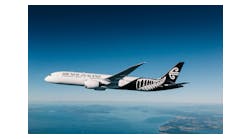July 31--As many in the state were bracing for Tropical Storm Flossie -- leaving work early, closing schools and visitor attractions, and canceling airline flights -- Hawaiian Airlines stayed the course.
More than 80 flights between Hawaii and the mainland or international destinations were canceled due to Flossie by nearly every airline that serves the state, but Hawaiian didn't call off a single trans-Pacific flight.
"We know the islands pretty well," said Hawaiian's dispatch manager Mark Spence, who developed the company's own weather software. "We saw this coming directly into Hilo, looked at the size, and it was a relatively small storm as storms go."
It turned out to be the right call as Flossie weakened before it got to Oahu, and Hawaiian avoided having to send passengers back to their hotels or homes.
That wasn't the case for other airlines, which canceled dozens of flights.
Hawaiian attributed its sound decision to the fact that it is based in the islands.
Hawaiian's large local workforce, familiarity with the islands, favorable flight schedule and proprietary weather software all contributed to the state's largest carrier operating as normal.
"I think (all the airlines) made a successful decision," said Capt. Ken Rewick, Hawaiian Airlines' vice president for flight operations. "We have a different set of resources here on the islands with Hawaiian in terms of our stations and the ability to move people between the islands. That's something the other carriers might not have. Also, the arrival times (were a benefit) because the main thrust of our operation is during midday."
Hawaiian had 35 mainland flights, 16 international routes and 178 interisland flights scheduled Monday for a total of 229, and all went off as scheduled except for one Honolulu-Maui round trip. That evening flight was in the air for 10 to 15 minutes of the scheduled 35-minute flight when it returned to Honolulu because the storm at that time hit its peak over Maui. All the passengers were put on another scheduled Honolulu-Maui flight less than an hour later.
"When we talked about this one, the pilot left knowing he had an option that he could safely return," said Capt. Kirk McBride, system chief pilot for Hawaiian. "It's very important for us to avoid the actual storm itself. We don't fly through the storms themselves. We fly through those areas where there's remnants. The whole purpose of airborne radar is to avoid the storms, and that's what we use to circumvent the storms."
United, American and Alaska airlines officials all cited safety concerns as the reasons they canceled flights. They also all waived change fees so that passengers could make other arrangements.
New York-based airline analyst Bob Mann said those airlines and others that canceled flights were at a disadvantage compared with Hawaiian.
"A carrier whose base of operation is in the affected area probably has the best view on how the weather will progress and what the effect on the operation will be, whereas anyone based off the island has to make a decision six to 10 hours in advance as to the weather arrival forecast," he said. "There's not a lot of alternate airports when you're flying to Hawaii."
Consequently, there were many disgruntled passengers Monday at Honolulu Airport when they arrived only to find out their flights had been canceled although Hawaiian was still flying. But Mann said those passengers likely didn't understand the circumstances the other carriers were facing.
"It's a two-way operation," Mann said. "The airplanes don't get magically assembled in Honolulu. They actually have to come in from somewhere, and if the incoming flight is canceled, the outgoing flight will be canceled as well."
Rewick, the VP of flight operations, said Hawaiian began tracking the storm activity about a week ahead of its expected arrival and developed a plan regarding schedule modifications as the storm grew closer to the islands.
"We have some of the best proprietary tools that can be used to model the storm in various dimensions that assist us in making these decisions," he said.
Spence, the dispatch manager, said airline officials paid particularly close attention to the size, direction and speed of the storm.
"A lot of it is about timing," Spence said. "We look at when we think the storm will arrive, and we see what direction it's coming in. ... We knew both Honolulu and Lihue would still remain with fairly good weather. As it came up on the Big Island, we then looked at the time of arrival of our West Coast flights into Honolulu and asked the question, Will the storm allow us to use Honolulu and still use Lihue as an alternate? And the answer to that was pretty much a consensus."
Copyright 2013 - The Honolulu Star-Advertiser




